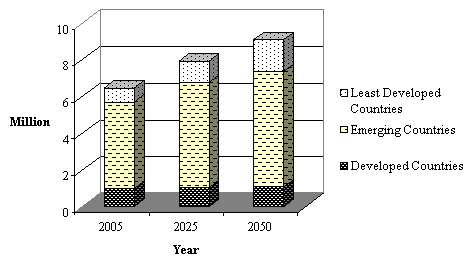| News | Events | Sites | Database | Knowledge Base | Forum |
|
General objective of this concept note Population, population growth and food production Agriculture: what role for development, which linkages with water? Water for agriculture: where do we stand? Which future? POPULATION, POPULATION GROWTH AND FOOD PRODUCTION The population in 2005 and prognosis for 2025 and 2050 are shown in Figure 1, details are given in Annex 1. From Figure 1 it can be observed that by far most of the population (73%) lives in the emerging countries, but that relatively most of the population growth is expected in the least developed countries. In the developed countries no growth is expected anymore. The population growth in the emerging and least developed countries is expected to be concentrated in the urban areas. With respect to agriculture it is of importance that it first of all plays a role to produce food crops. However, also a variety of non-food crops, like cotton, tobacco, flowers, etc. may be produced on agricultural land. A recent development that may have far reaching consequences is the cultivation of bio-fuel products, like sugar cane, oil palm and maize. In fact it implies that for a substantial part of this production food-producing lands are transformed to non-food producing lands. With respect to this it is interesting to observe how prices for the basic food crops have developed over the past period. After a continuous lowering of global food prices during many decades, the bottom was more or less reached in 2000 - 2001, since then prices at the World Market are rising. This will make it increasingly difficult for the urban poor in the emerging and least developed countries to purchase their food (Annex 1).
Figure 1. Population in 2005 and prognoses for 2025 and 2050 (Schultz, et al., 2005) Notwithstanding some measures for the control of the population growth undertaken by some of the emerging and least developed countries which could retard and perhaps stabilise the population say by 2050, the projected needs for an increased population of about 8 billion people are to be properly planned. In respect of the emerging and least developed countries where the population growth will take place, these countries will be confronted with the need to increase their food supply by a larger production in their own territory, may be in combination with increased imports. For the emerging countries there is the additional complication that the standard of living is rapidly rising resulting in an increase in consumption per person and a change in diet. From the point of view of food production there is a common feeling that in the coming decades about 80 - 90% of the required increase will have to be realised on existing cultivated land and about 10 - 20% on newly reclaimed land. From the point of view of sustainable rural development, socio economic and environmental aspects play in particular, crucial rolesþ If we look at the production of cereals in the three types of countries, as well as in the different Continents, then the following general conclusions can be drawn (Annex 1). The developed countries have an export surplus of about 10% of their production. The emerging countries have a net import, but this is quite low if we express it in deficit per person and it looks like they are overall able to be food self sufficient. Striking is that the least developed countries have an import surplus in cereals of 30% of their own production. Granting that, in the absence of water management facilities, these figures could vary due to the linkages with the variations in precipitation, planning for the global requirements would have to be on a robust basis of projected trends. The solutions for such tendencies, that are temporal with linkages with climate, are best solved by interventions, which can insulate the impact of variations in climate. With respect to this the declining trend in investments in the sector - at least from international donors - during the last decade needs a critical review. The question is if in consultation with the local governments, could this trend be reversed? Is it needed and if so which may be the priorities? Conclusions It is considered to be of importance that the debate with respect to this issue will be triggered, that awareness is raised and that priorities for action be presented and discussed during the next World Water Forum in Istanbul (WWF5). Crucial points are:
|
